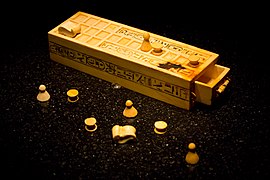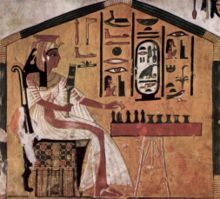Senet
| Senet in hieroglyphics | |||
|---|---|---|---|
Senet Sn.t passage / passage |
|||
| Senet playset from ivory with inserts ( grave of Tutanchamun ) | |||
Senet (from the ancient Egyptian verb for “pass” or “walk through”) is an ancient Egyptian board and parlor game that enjoyed great popularity , especially among the upper classes and has been around since at least 3000 BC. Is occupied. It was played until the post-Christian period around 300 AD and was not similar to today's board games, Backgammon and Mensch-ärgere-dich-dich .
description
A typical Senet game set consisted of a game board , differently designed game pieces and so-called counting bones. The game board was rectangular, usually measuring 35 × 10 cm or 55 × 20 cm and had exactly thirty playing fields on its top, ten in a row. For this reason Senet was also called "the 30-field game". The counting bones were plate-shaped and had a different number of counting marks on each side. The figure set included three large, cone-shaped figures and four slightly smaller, coil-shaped game pieces. The entire set could be made of wood , ceramic , ivory or faience .
regulate
Senet was played by two players. The journey began in a field labeled "Birth". The last five fields contained the miniature representations of deities and words: Horus ; Re + Osiris ; Month (or Thot ) + Schu + Maat ; Semataui and, last but not least, Per-nefer (the "house of good"). Spread over the rows of games there were four fields that brought luck or bad luck. These were more or less unevenly scattered. For example, there was the “flood” field, which forced the player to remove his character from the game. The “frog / toad” playing field, on the other hand, brought luck - the player was allowed to double count his next point roll. Each player got seven figures, which were called Ibau ("dancer"). Depending on how many counting lines the counting bones pointed up after a throw, the player was allowed to move forward with a figure of his choice. The aim of the game was to be the first to arrive in one of the last houses with all the remaining pieces.
Mythological meaning
Senet was not only for entertainment, but also had a religious meaning. The board game text contains many references to the course of the sun and the dean stars . The constellation Orion , which embodied Osiris , is mentioned by name. A connection can also be seen in the mentions of the nut book , the content of which is in accordance with the aim of the game. A clear reference can be made to the Chatiu demons who are in the embalming workshop in order to solve the problem . Mythologically, the players assume the role of decision-makers about their fate.
Well-known representations and finds
Numerous finds, descriptions and illustrations suggest that Senet has apparently existed since the early dynastic epochs . Toy figures that clearly belong to Senet play sets were found in tombs of the 1st Dynasty . A wall painting in the Mastaba des Hesire ( 3rd Dynasty , Old Kingdom ) in Saqqara shows the oldest complete picture of a game of Senet. Other well-known representations can be found in the mastabas of the Old Kingdom, often in scenes from celebrations and banquets . Such a banquet can be seen in the Mastaba des Idu ( 6th Dynasty ) in Saqqara, at which - in addition to Senet - several board games, including Mehen , are played.
In 2006, the Spanish Egyptologist José Manuel Galan discovered a 3,500 year old Senet game. It comes from the graves of the high Egyptian officials Djehuti and Heri from the 18th dynasty . The pieces made of wood and ivory are considered to be one of the most important finds from the time of the New Kingdom . Some Senet play sets have also been found in Tutankhamun's tomb .
See also
- Twenty fields game . Also a board game similar to Senet and introduced by the Hyksos .
- Mehen . Another board game dedicated to the deity of the same name .
literature
- Erwin Glonnegger : The game book: board and placement games from all over the world; Origin, rules and history . Drei-Magier-Verlag, Uehlfeld 1999, ISBN 3-9806792-0-9 .
- Alexandra von Lieven : Floor plan of the course of the stars - the so-called groove book . The Carsten Niebuhr Institute of Ancient Eastern Studies (among others), Copenhagen 2007, ISBN 978-87-635-0406-5 .
- Edgar B. Pusch: The Senet board game in ancient Egypt. The inscribed and archaeological material (= Munich Egyptological studies . Volume 38). Deutscher Kunstverlag, Munich / Berlin 1979, ISBN 3-422-00831-4 .
- Joyce Tyldesley : Egyptian Games and Sports (= Shire Egyptology. Vol. 29). Shire, Princes Risborough 2008, ISBN 978-0-7478-0661-5 , pp. 12-14.


